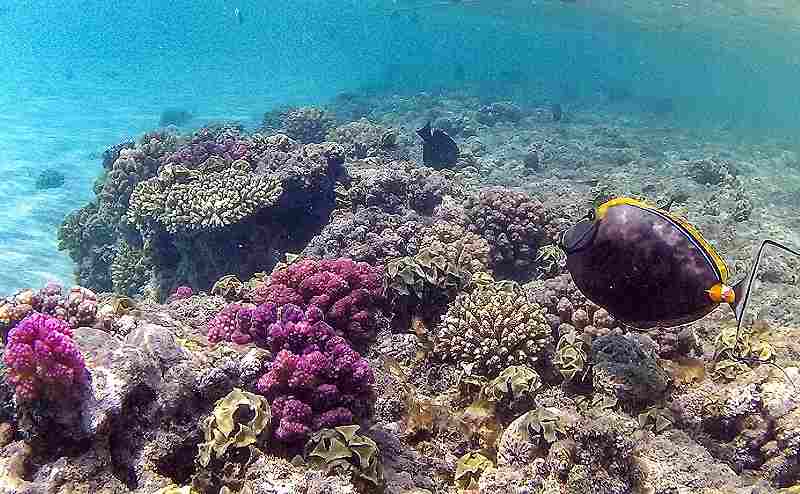
Orange-spine unicornfish, also known as barcheek unicornfish or naso tang, swim near a coral reef off the dive spot of Abu Dabbab along Egypt’s southern Red Sea coast north of Marsa Alam on Sept. 17.
12:50 JST, November 5, 2022
MARSA ALAM, Egypt (AFP-Jiji) — Beneath the waters off Egypt’s Red Sea coast a kaleidoscopic ecosystem teems with life that could become the world’s “last coral refuge” as global heating eradicates reefs elsewhere, researchers said.
Most shallow water corals, battered and bleached white by repeated marine heatwaves, are “unlikely to last the century,” the Intergovernmental Panel on Climate Change said this year.
That threatens a devastating loss for the hundreds of millions of people worldwide who depend on the fish stocks that live and breed in these fragile ecosystems.
Even if global warming is capped within Paris climate goals of 1.5 C above pre-industrial levels, 99% of the world’s corals would be unable to recover, experts said.
But Red Sea coral reefs, unlike those elsewhere, have proven “highly tolerant to rising sea temperatures,” said Mahmoud Hanafy, professor of marine biology at Egypt’s Suez Canal University.
Scientists hope that at least some of the Red Sea corals — 5% of the total corals left worldwide — could cling on amid what is otherwise a looming global collapse.
“There’s very strong evidence to suggest that this reef is humanity’s hope for having a coral reef ecosystem in the future,” Hanafy said.
Eslam Osman from the King Abdullah University of Science and Technology in Saudi Arabia said: “It is crucial that we preserve the northern Red Sea as one of the last standing coral refuges, because it could be a seed bank for any future restoration effort.”
Livelihoods for half billion
The impacts of coral loss are dire: they cover only 0.2% of the ocean floor, but are home to at least a quarter of all marine animals and plants, helping sustain livelihoods for half a billion people worldwide.
Global warming, as well as dynamite fishing and pollution, wiped out a startling 14% of the world’s coral reefs between 2009 and 2018, according to the Global Coral Reef Monitoring Network.
Graveyards of bleached coral skeletons are now left where once vibrant and species-rich ecosystems thrived.
Recent studies have shown the northern Red Sea corals are better able to resist the dire impact of heating waters.
“We have a buffer temperature before the coral sees bleaching,” Osman said. “1, 2, even 3 C of warming, we’re still on the safe side.”
Osman said one theory explaining the corals’ apparent resilience to heat is due to “evolutionary memory” developed many thousands of years ago, when coral larvae migrated north from the Indian Ocean.
“In the southern Red Sea, coral larvae had to pass through very warm waters, which acted as a filter, only letting through species that could survive up to 32 C,” Osman said.
However, scientists warn that even if Red Sea corals survive surging water temperatures, they risk being damaged from non-climate threats — pollution, overfishing and habitat destruction including from costal development and mass tourism.
“When non-climate threats increase, the vulnerability to climate change increases as well,” Osman said.
"Science & Nature" POPULAR ARTICLE
-

Genome Study Reveals Milestone in History of Cat Domestication
-

Big Leap in Quest to Get to Bottom of Climate Ice Mystery
-

Japan Set to Participate in EU’s R&D Framework, Aims to Boost Cooperation in Tech, Energy
-

Paws on Parade: Nairobi’s Dogs Dazzle at ‘Pawchella’
-

Japan’s H3 Rocket Failed in Latest Launch, Says Official
JN ACCESS RANKING
-

Tokyo Economic Security Forum to Hold Inaugural Meeting Amid Tense Global Environment
-

Keidanren Chairman Yoshinobu Tsutsui Visits Kashiwazaki-Kariwa Nuclear Power Plant; Inspects New Emergency Safety System
-

Imports of Rare Earths from China Facing Delays, May Be Caused by Deterioration of Japan-China Relations
-

University of Tokyo Professor Discusses Japanese Economic Security in Interview Ahead of Forum
-

Japan Pulls out of Vietnam Nuclear Project, Complicating Hanoi’s Power Plans























